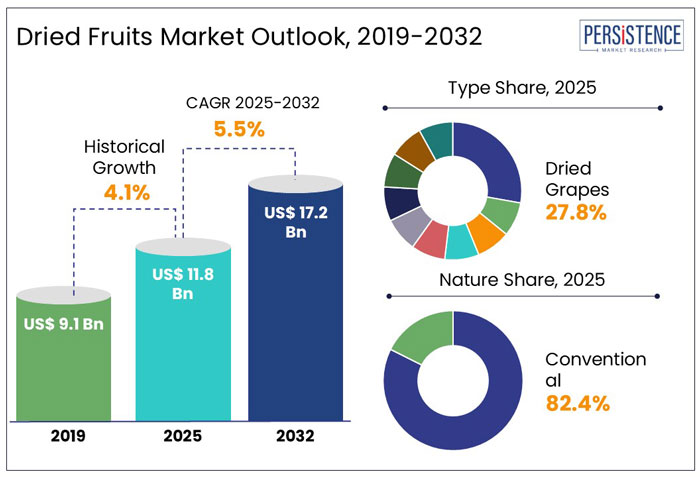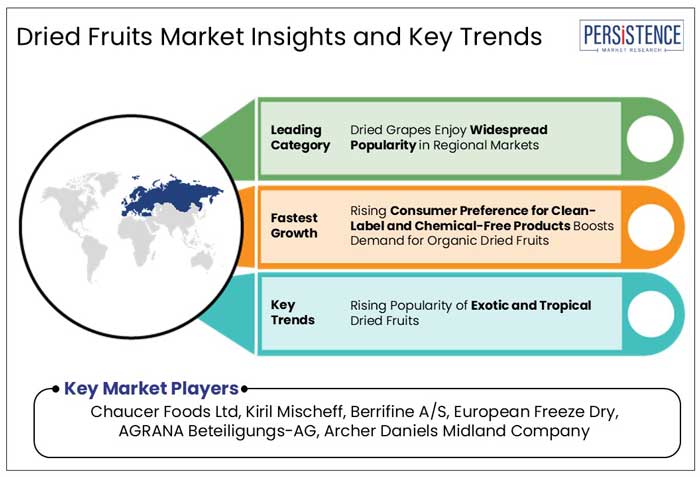Industry: Food and Beverages
Published Date: February-2025
Format: PPT*, PDF, EXCEL
Delivery Timelines: Contact Sales
Number of Pages: 400
Report ID: PMRREP32279
The global dried fruits market is valued at US$ 11.2 Bn by the end of 2024 and is projected to grow at a CAGR of 5.5% and reach a valuation of US$ 17.2 Bn by 2032.

| Attribute | Key Insights |
|---|---|
|
Dried Fruits Market Size (2025E) |
US$ 11.8 Bn |
|
Projected Sales of Dried Fruits (2032F) |
US$ 17.2 Bn |
|
Value CAGR (2025-2032) |
5.5% |
|
Value Share of Top 5 Countries (2024A) |
57.7% |
As per a study of Persistence Market Research, the dried fruit market accounts for around 4% to 6% share of the global fruits and vegetables market.
The global dried fruits market registered a value CAGR of 4.1% during the historical period of 2019 to 2023. Consumer awareness regarding health and well-being is increasing, which affects their food consumption habits. Consumers are becoming more health conscious as the prevalence of various diseases rises, influencing them to choose products that are better for their health and nutrition.
Fiber, potassium, folate, and magnesium are present in dried fruits. They also have antioxidant properties that help increase insulin responsiveness and reduce oxidative stress and inflammation in the pancreas. Dehydrated fruits are rich with vitamin C, which boosts the immune system and improves skin quality.
Over the forecast period (2025-2032), the global dried fruits market is projected to witness steady market growth at a CAGR of 5.5%. Growing consumer preferences for organic, sugar-free, and high-nutrient products are expected to drive the dried fruits market. The market is also becoming more accessible due to the rise of e-commerce, creative packaging, and sustainability tendencies. The growing usage of dried fruits in cereals, baked goods, and confections in the food service industry contributes to growth.
“Increasing Consumer Inclination toward Clean Label Products to Drive Sales of Dried Fruits”
Consumer awareness about the negative consequences of added colors and flavors has influenced them to choose healthier eating habits. Clean labels or label-friendly cut through the clutter of too much data and represent valuable information, which gives consumers a sense of control over their well-being. Clean label items are in high demand because consumers want food without artificial additives or preservatives.
Dehydrated fruit manufacturers are optimising ingredients to provide label-friendly products. Customers are looking at the back of packages more than ever before to check for the ingredients, and are drawn to clean-label products, which was previously uncommon, resulting in an increase in demand for preserved fruits that require less processing.
“Channel Proliferation to Provide Market Growth Opportunities to Manufacturers of Dried Fruit Products”
The dried fruits market is highly fragmented, and manufacturers are seeking the shortest path to reach out to consumers. Dried fruit manufacturers are accessing new sales channels to connect with a diverse consumer base. This is expected to increase the product availability of dried fruits from various brands.
High fragmentation in the industry, coupled with a lack of brand awareness and consumer loyalty, are emerging as significant factors in the increase in retail sales of dried fruits, which add nutrition content to meals.
Internet sales are booming, thanks to the ease of access to products, convenient purchases, and increased choice across brands. This is expected to create more sales opportunities for manufacturers by targeting health-conscious consumers.
“Consumer Preference for Ready-to-Use Food Products Complementing Market Expansion”
The foodservice industry is increasingly looking for easy, time-saving ingredients that may boost efficiency while maintaining high quality requirements. Dried fruits make baking and food manufacturing easier by lowering ingredient preparation time, making them perfect for cakes, pastries, donuts, dairy products, snacks, and cereal. Their versatility, long shelf life, and ease of usage enable bakers and food manufacturers to respond to changing customer expectations for natural, tasty, and nutrient-dense ingredients.
Furthermore, dried fruits like apples, strawberries, and apricots improve taste and texture, hence boosting the whole consumer experience. As demand for premium, personalized, and health-conscious products rises, the usage of dried fruits in bread, dairy, and confectionery applications gives lucrative growth potential, accelerating market expansion. The convenience factor reinforces the market's long-term upward trend.
“High Pricing of Dehydrated Fruits to Hamper Market Growth to Some Extent”
The perishable nature of fruits makes dried fruits a highly import-dominant food product. This attracts import duties, freight charges, customs, and logistical charges, which increases prices. The density of dried fruits is another factor which adds on to the cost of the end product.
The freeze-dried process of the production of drying fruits is expensive and adds to the final price of the product. Thus, availability of cheaper options and dried fruits being on the higher side of the price scale are expected to hamper sales to some extent.
Cognizance about the food content among consumers has increased substantially in the past few decades. Consumers are avoiding processed food due to rising health-consciousness.
Increased number of customers are hesitant toward the consumption of packaged food and are preferring food products that are fresh and naturally available. Hence, the conscious minds of consumers regarding the vitamins and nutritional content in fresh food is drawing them toward freshly available fruits instead of dried fruits.
Moreover, adulteration during processing is one of the major concerns restraining hypersensitive consumers from consuming dried fruits. Dried fruits are also known to lose some of the nutritional content as compared to fresh fruits, which is expected to hamper overall sales of dried fruits during the forecasted period.
How is the European Market for Dried Fruits Shaping Up?
“Regional Market Growth Led by Germany, France, and the U.K.”
The U.K., Germany, and France are major countries that hold the largest value share in the European dried fruits market. Together these countries account for approx. 50% market share of the European dried fruits market.
Convenience foods have become indispensable in urban kitchens whilst being great time-savers for consumers with hectic schedules. Rise in the working population has shown inclination toward convenience food and packaging. Thus, consumers are preferring dried fruits as they meet their requirements.
Who is Leading Market Expansion in South Asia?
“India's Dried Fruits Market is showing promising growth for Industry Players”
In the South Asian market, India is showing high-potential growth for the forecast period and is expected to register a significant value CAGR of 7.7%. Demand for dehydrated fruits is high as consumers are adopting food products that have potent health benefits to combat heart diseases and promote weight loss.
Which is the Most Popular Dried Fruit Globally?
“Dried Grapes Enjoy Widespread Popularity in Regional Markets”
Based on type, grapes are highly demanded and consumed in the dried fruits category, and hold a market value share of more than 27%. Grapes are rich in vitamins and minerals that help boost the immune system and fight infectious diseases. Their antibacterial and anti-inflammatory properties help cure infections, viral fevers, and many others types of illnesses.
Which End-use Vertical Accounts for Most Demand?
“Consumption of Dried Fruits Highest in Foodservice Industry”
The most significant user of dried fruits is the foodservice sector because of their various applications, long shelf life. Dried fruits are used in gourmet meals, salads, desserts, cereals, and bakeries and confectioneries to improve taste and nutrition. Additionally, hotels and airlines include dried fruits in their breakfast buffets and snack selections. They are also perfect for producing food on a wide scale due to their affordability and low storage needs. Based on end use, the food service industry is showing promising growth and is set to register a CAGR of 5.8% during the forecast period (2025-2032).

Emergence of the new coronavirus had a considerable influence on the fruits and vegetable market. Producers and distributors of fruits were obliged to shift completely from the foodservice to the retail channel as a result of the closure of bars, restaurants, and schools.
Shippers mentioned that the change was difficult due to manpower and logistical issues, but the fresh supply chain remained robust. Consumers' buying patterns have shifted toward online retailing, as there are increased constraints on immigrant labor markets and a higher concentration of customers desiring fruits with longer shelf lives.
Availability and protection of workers, including industrial conditions, logistical constraints, seasonal workers, and disruptions were all issues experienced across the supply chain. However, most processing plants remained open despite the adversity.
The preserved fruits and vegetables sector, such as dried fruits, is considered as an essential to meeting the rising customer demand for safe, healthy, long-lasting products, but stringent adherence to COVID-19 hygiene norms and processes continued to result in increased production costs.
Dried fruit manufacturers focus on improving their product quality by investing in research and development activities. Companies are also launching new products to expand their customer base and increase their market presence worldwide. Furthermore, leading players in the market are prioritizing eco-friendly packaging, carbon footprint reduction, and sustainable sourcing to meet consumer demand for ethical goods.
|
Report Attributes |
Details |
|
Historical Data/Actuals |
2019 – 2024 |
|
Forecast Period |
2025 – 2032 |
| Market Analysis Units | Value: US$ Bn/Mn, Volume: As applicable |
|
Geographical Coverage |
|
|
Segmental Coverage |
|
|
Competitive Analysis |
|
|
Report Highlights |
|
|
Customization and Pricing |
Available upon request |
By Type:
By Nature:
By Form:
By End Use:
By Distribution Channel:
By Region:
To know more about delivery timeline for this report Contact Sales

The global dried fruits market is currently valued at close to US$ 11.8 Bn.
The U.K., Germany, and France are the major countries with the largest market value share in the European dried fruits market.
AGRANA Beteiligungs-AG, Archer Daniels Midland Company, Sun-Maid Growers of California, Döhler, and Ceres Organics are the top 5 suppliers of dried fruits, holding approximately 20% to 30% share in the global market.
India is showing high-potential growth in the South Asian dried fruits market.
Grapes are the most highly demanded and consumed dried fruit.